By Kristin Jacques, author of Ragnarök Unwound, forthcoming from Sky Forest Press
The Valkyrie has made a comeback in a big way. While this Norse mythological figure has cropped up from time to time in the modern era, the influx and influence of mythology in recent media has lifted the Valkyrie in a new direction. There is now an abundance of depictions in comic books, novels, television shows and blockbuster films, where the Valkyrie has become synonymous with the B.A.M. (Bad Ass Motha), the tough-as-nails female heroine. This archetypal heroine is a cornerstone in several genres, such as Urban Fantasy.
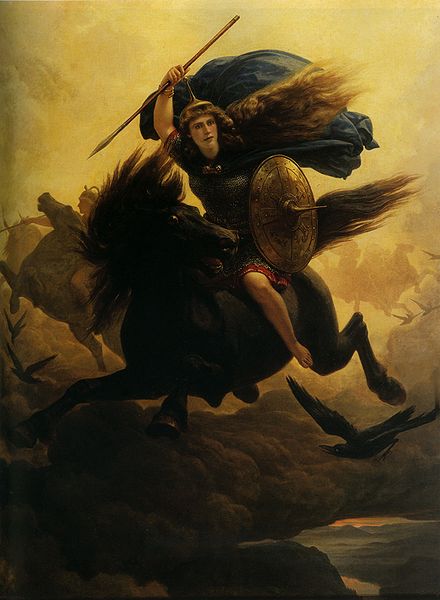
This representation is not a far cry from their Norse origins, though newer incarnations present a somewhat sanitized version of the original myth, focusing on the noble characteristics of these female extensions of the All Father. The hint of their dark origins is in the etymology of their name.
 To break down the old Norse Valkyrjur, Valr referred to the slain of the battlefield and kjósa, meant ‘to choose.’ Valkyrie translated to ‘Choosers of the Slain,’ a title that not only encompassed their choice of which warriors were granted Valhalla status, but who would die in battle. Valkyries didn’t shy away from invoking some heavy-duty black magics to ensure their choices came to fruition. In Njal’s Saga, there is an instance of twelve Valkyrie gathered around a loom, weaving fate like the Norns, though their materials are far grimmer. Here, the Valkyrie use intestines for thread, severed heads for weights, and swords and arrows for beaters, while they gleefully chant their hit list. The Saga of the Volsungs compares the sight of a Valkyrie to ‘staring into an open flame.’ To the Anglo-Saxons, they were spirits of carnage.
To break down the old Norse Valkyrjur, Valr referred to the slain of the battlefield and kjósa, meant ‘to choose.’ Valkyrie translated to ‘Choosers of the Slain,’ a title that not only encompassed their choice of which warriors were granted Valhalla status, but who would die in battle. Valkyries didn’t shy away from invoking some heavy-duty black magics to ensure their choices came to fruition. In Njal’s Saga, there is an instance of twelve Valkyrie gathered around a loom, weaving fate like the Norns, though their materials are far grimmer. Here, the Valkyrie use intestines for thread, severed heads for weights, and swords and arrows for beaters, while they gleefully chant their hit list. The Saga of the Volsungs compares the sight of a Valkyrie to ‘staring into an open flame.’ To the Anglo-Saxons, they were spirits of carnage.
At some point the representation shifted from ‘warrior’ to ‘shield maiden,’ and there, a fine distinction began to surface. Valkyrie served as projections, parts of a greater whole. The Valkyrie were an extension of Odin, but as the focus shifted to their nobler deeds, so too did their autonomy expand. Odin might dictate their choice of who died in battle, but the Valkyrie, such as Brunhild or Sigrun, chose their lovers. They chose mortals to favor and protect. They became susceptible to the vices and failings of mortals, just like other Norse deities. They became more human.

It was this association with fairness, brightness, gold, and bloodshed that has resurfaced in depictions of the modern Valkyrie. There has also been a bit of an amputation from the All Father. A single Valkyrie is a B.A.M., but she comes with a sisterhood. Recent Valkyrie representations include everything from Tessa Thompson’s very memorable kick-butt turn as Marvel’s Valkyrie in the third Thor outing to Rachel Skarsten’s Tamsin in the fantasy femme fatale brawl that is Lost Girl. [pictured: Tessa Thompson as Valkyrie in Marvel’s Thor: Ragnarok.]
In Marvel’s hot take, the Valkyrie were an elite band of female warriors who served in Odin’s army, with Thompson’s character adrift and rudderless without her sisters. (Slight spoiler: she comes back swinging.) Here at least Odin is present, but the Valkyrie, particularly Thompson, have complete autonomy over themselves.

The Valkyrie in the Canadian fantasy drama Lost Girl give a fair nod to their dark origins. Here, the Valkyrie don’t answer to Odin at all, but to Freyja. They still have the soul-taker gig, but with a twist. The Valkyrie consider one another sisters, and they fight like sisters, though the hair is off-limits.
For my own depiction of Valkyrie in Ragnarök Unwound, I draw on the more bombastic qualities present in the myths and modern incarnations in the creation of Hildr—fierce, loyal, and quite literal. Isolated from her sisters, Hildr builds a new sisterhood with the other female characters of the novel to fight the good fight.
A common factor in these modern depictions is while the Valkyrie are singularly B.A.M., the Sisterhood is a force of nature. They draw strength from one another and in turn give their strength to one another.
This mentality of sisterhood carries over into women’s culture. We all want to be Wonder Woman. We want to be the B.A.M., but we are strongest when we lift each other. We raise our sisters on our shields. No matter the depiction, the world they inhabit, or who their boss is, Valkyrie are the Sisterhood of the Fierce.
Sources:
The Saga of the Volsungs
The Viking Spirit by Daniel McCoy
Norse-mythology.org
Lost Girl
Thor: Ragnarok
Featured image: Arthur Rackham, “Wagner’s Ring Cycle: The Valkyrie,” 1910


 That’s one of the reasons I was attracted to Ragnarök Unwound, written by Kristin Jacques, author of Zombies Vs. Aliens and the upcoming Marrow Charm from Parliament House Press. Ragnarök Unwound is the story of Ikepela Ives, who is known as the Fate Cipher. The Fate Cipher’s job is to untangle the threads of fate. The only problem is Ives is the first part-mortal Cipher, and no one ever taught her how to use her powers. She runs away from her duty until one day, she can’t anymore. A Valkyrie locates her in a bar and pleads for her help in stopping Ragnarök, which has been set in motion. Jacques blends Norse and Hawaiian mythology for a truly unique tale filled with a unique ensemble cast.
That’s one of the reasons I was attracted to Ragnarök Unwound, written by Kristin Jacques, author of Zombies Vs. Aliens and the upcoming Marrow Charm from Parliament House Press. Ragnarök Unwound is the story of Ikepela Ives, who is known as the Fate Cipher. The Fate Cipher’s job is to untangle the threads of fate. The only problem is Ives is the first part-mortal Cipher, and no one ever taught her how to use her powers. She runs away from her duty until one day, she can’t anymore. A Valkyrie locates her in a bar and pleads for her help in stopping Ragnarök, which has been set in motion. Jacques blends Norse and Hawaiian mythology for a truly unique tale filled with a unique ensemble cast.

 The Sumerian Ereshkigal is one of the earliest examples of an underground death goddesses. She is featured prominently in the Descent of Inanna, as her sister who ultimately slays Inanna and hangs the body on a meat hook along the wall of the afterlife. Inanna’s journey to the underworld is a process of stripping away parts of herself, culminating eventually in the stripping of her very life. Ereshkigal slays her sister because all those who enter the underworld must experience death. “She who receive the me of the underworld does not return. She who goes to the Dark City stays there.”
The Sumerian Ereshkigal is one of the earliest examples of an underground death goddesses. She is featured prominently in the Descent of Inanna, as her sister who ultimately slays Inanna and hangs the body on a meat hook along the wall of the afterlife. Inanna’s journey to the underworld is a process of stripping away parts of herself, culminating eventually in the stripping of her very life. Ereshkigal slays her sister because all those who enter the underworld must experience death. “She who receive the me of the underworld does not return. She who goes to the Dark City stays there.”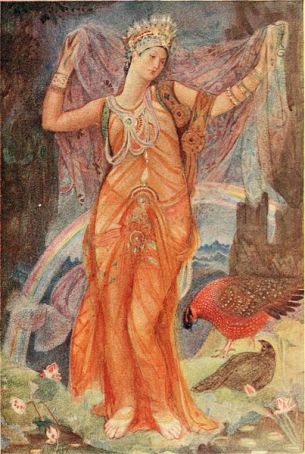 specifically linked to death, her nature is ultimately both primordial and dualistic. She existed before the world was created. Her identity is both the absence of light as well as the absence of order and one can further compare a symbolic connection to life and death cycles. Interestingly enough, Nyx is believed to have been the mother of the incarnations of light and day. Again, the dualistic existence is prominent. Cycles are of utmost importance as one exists alongside the other.
specifically linked to death, her nature is ultimately both primordial and dualistic. She existed before the world was created. Her identity is both the absence of light as well as the absence of order and one can further compare a symbolic connection to life and death cycles. Interestingly enough, Nyx is believed to have been the mother of the incarnations of light and day. Again, the dualistic existence is prominent. Cycles are of utmost importance as one exists alongside the other.



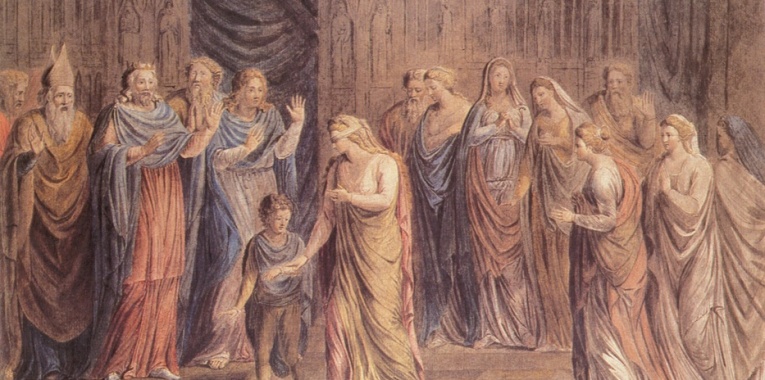
 hadow on the Crown is the first book in Patricia Bracewell’s trilogy about the real-life Emma of Normandy, who was queen of England twice over. Emma was married off to King Æthelred of England in 1002 by her brother Richard, the duke of Normandy, to form an alliance they hope will keep the Danes away from their shores. Although Æthelred’s first wife was only a consort, Richard makes Emma’s crowning a requirement of the treaty.
hadow on the Crown is the first book in Patricia Bracewell’s trilogy about the real-life Emma of Normandy, who was queen of England twice over. Emma was married off to King Æthelred of England in 1002 by her brother Richard, the duke of Normandy, to form an alliance they hope will keep the Danes away from their shores. Although Æthelred’s first wife was only a consort, Richard makes Emma’s crowning a requirement of the treaty. bearing children confers power on women in general and on queens in particular, it’s a power that isn’t absolute. Æthelred’s first wife dies in childbirth, and Bracewell mentions that Emma’s own mother had lost three children in addition to giving birth to eight surviving ones. Emma’s rival for the king’s affections, Elgiva, knows that if Emma has a child, it will reinforce her standing as queen. When Emma becomes pregnant, Elgiva has her waiting woman slip poison into Emma’s wine to cause her to miscarry. There is no easily available source for Emma experiencing a miscarriage, so it’s safe to say this is a fictional part of historical fiction. However, the point stands. Forcing Emma to miscarry is a way for Elgiva to take Emma’s power away and to assert her own.
bearing children confers power on women in general and on queens in particular, it’s a power that isn’t absolute. Æthelred’s first wife dies in childbirth, and Bracewell mentions that Emma’s own mother had lost three children in addition to giving birth to eight surviving ones. Emma’s rival for the king’s affections, Elgiva, knows that if Emma has a child, it will reinforce her standing as queen. When Emma becomes pregnant, Elgiva has her waiting woman slip poison into Emma’s wine to cause her to miscarry. There is no easily available source for Emma experiencing a miscarriage, so it’s safe to say this is a fictional part of historical fiction. However, the point stands. Forcing Emma to miscarry is a way for Elgiva to take Emma’s power away and to assert her own.
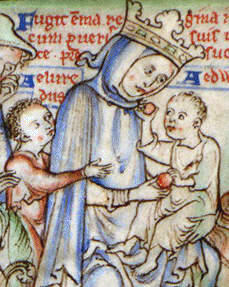 he few forms of power available to them can be inspiring to read about.
he few forms of power available to them can be inspiring to read about.
 pagan movement of modern day), the Bodhi Tree, its very name meaning the awakening or enlightenment of Buddha, and the Tree of Knowledge of the Judaic tradition. In each depiction, there are strong connections to humanity and the human experience. While the divine, or immortal may be connected to the tree, it is often in a human-like capacity that ascends into some type of enlightenment (in the case of monotheism, knowledge that leads to disaster). This can be explained by the idea that the tree is a mirror of humanity itself – ever rooted to the Earth by reaching for something greater, something higher, caught in a state in-between.
pagan movement of modern day), the Bodhi Tree, its very name meaning the awakening or enlightenment of Buddha, and the Tree of Knowledge of the Judaic tradition. In each depiction, there are strong connections to humanity and the human experience. While the divine, or immortal may be connected to the tree, it is often in a human-like capacity that ascends into some type of enlightenment (in the case of monotheism, knowledge that leads to disaster). This can be explained by the idea that the tree is a mirror of humanity itself – ever rooted to the Earth by reaching for something greater, something higher, caught in a state in-between.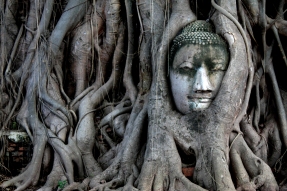 repetitive in Western culture. I’d like to examine these through the lens of the Greek myth of Daphne, the nymph lustfully pursued by Apollo until she is transformed into the laurel tree in order to escape. It is a timely myth to revisit for the modern audience, as many women via the Me Too movement have spoken out against male sexual misconduct, particularly from powerful men. It has spurred not only conversations on the sexual harassment, pressure and assault on women, but questions concerning sex and power dynamics.
repetitive in Western culture. I’d like to examine these through the lens of the Greek myth of Daphne, the nymph lustfully pursued by Apollo until she is transformed into the laurel tree in order to escape. It is a timely myth to revisit for the modern audience, as many women via the Me Too movement have spoken out against male sexual misconduct, particularly from powerful men. It has spurred not only conversations on the sexual harassment, pressure and assault on women, but questions concerning sex and power dynamics. greater, a life-threatening or ruining possibility.
greater, a life-threatening or ruining possibility.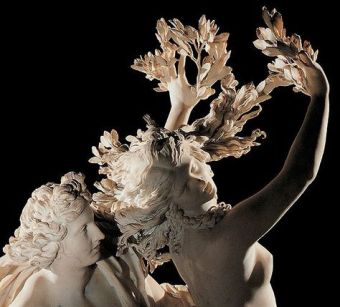 Daphne is described as athletic and when she flees, she gives a difficult pursuit for Apollo. But he is ultimately a god, so he is able to gain ground on her. Despite Daphne’s abilities, she cannot escape Apollo’s will. We could read this as despite female abilities and potential, women cannot escape society’s will.
Daphne is described as athletic and when she flees, she gives a difficult pursuit for Apollo. But he is ultimately a god, so he is able to gain ground on her. Despite Daphne’s abilities, she cannot escape Apollo’s will. We could read this as despite female abilities and potential, women cannot escape society’s will.
 the withdrawal of God’s protection. In Celtic culture, trees, or a grove can serve as a gateway to the realm of the faery, a mysterious world of amazement and entrapment, rife with equal parts wonder and danger. Such transformations and withdrawal from societal cooperation are by nature threatening to that society, but there is a freedom that can be found.
the withdrawal of God’s protection. In Celtic culture, trees, or a grove can serve as a gateway to the realm of the faery, a mysterious world of amazement and entrapment, rife with equal parts wonder and danger. Such transformations and withdrawal from societal cooperation are by nature threatening to that society, but there is a freedom that can be found. I met a lady in the meads,
I met a lady in the meads, warning to men of what could happen if women were allowed such self-direction. Indeed it hints at the very destruction of male power structures, “…pale kings and princes too, pale warriors, death-pale were they all.”
warning to men of what could happen if women were allowed such self-direction. Indeed it hints at the very destruction of male power structures, “…pale kings and princes too, pale warriors, death-pale were they all.”
 roles, sometimes in sequence, sometimes simultaneously. There wasn’t a common of locked-in fate or unalterable identity that was held for a lifetime. Certainly there were exceptions, just as there were exceptions to the marriage/motherhood role of Christian Europe. These were viewed as parts of a woman’s life. The ravages of disease, childbirth and violence most likely helped promote this, as women who survived could easily find themselves a mother or wife one moment and not the next. Since the emphasis on virginity and sexual faithfulness did not hold the strength it did in the Christian world, this additionally contributed to freedom of movement for women into many roles.
roles, sometimes in sequence, sometimes simultaneously. There wasn’t a common of locked-in fate or unalterable identity that was held for a lifetime. Certainly there were exceptions, just as there were exceptions to the marriage/motherhood role of Christian Europe. These were viewed as parts of a woman’s life. The ravages of disease, childbirth and violence most likely helped promote this, as women who survived could easily find themselves a mother or wife one moment and not the next. Since the emphasis on virginity and sexual faithfulness did not hold the strength it did in the Christian world, this additionally contributed to freedom of movement for women into many roles.
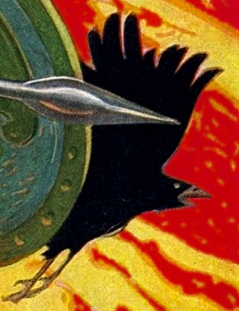 identities is segmented into three aspects where she represents the maiden, mother and crone. The dark and often chilling Celtic goddess Morrigan is among those who play seemingly competing roles as she represents both war and fertility. Sometimes “Morrigan,” is instead a title that contains three goddesses: Badb, Macha, Nemain.
identities is segmented into three aspects where she represents the maiden, mother and crone. The dark and often chilling Celtic goddess Morrigan is among those who play seemingly competing roles as she represents both war and fertility. Sometimes “Morrigan,” is instead a title that contains three goddesses: Badb, Macha, Nemain.


